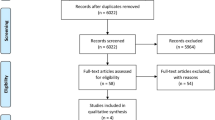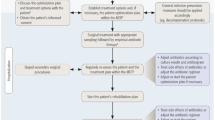Abstract
Purpose
To evaluate the effectiveness of vancomycin prophylaxis on spinal implant metal types.
Methods
42 rabbits underwent posterior, single-level instrumentation at L5-L6 with stainless steel (n = 18), cobalt chrome (n = 12), or titanium (n = 12) wire. All implants were inoculated with 1 × 106 colony forming units (CFU) of methicillin-resistant S. Aureus (MRSA). In the intrawound vancomycin subgroup (n = 18, 6 from each metal type), 40 mg of vancomycin powder was placed in the wound. In the IV vancomycin subgroup (n = 6, all stainless steel), 15 mg/kg of IV vancomycin was given preoperatively. Local soft tissue and implants were harvested 1-week postoperatively and separately cultured.
Results
Intrawound vancomycin significantly reduced the rate of soft tissue infection (44.4% vs 100%) and implant infection (27.8% vs 100%) (p < 0.001). Within the intrawound vancomycin subgroup, cobalt chrome implants were associated with higher median soft tissue MRSA growth (130 CFU) than stainless steel (0 CFU) or titanium (0 CFU) (p = 0.02). Cobalt chrome implants were also more likely to develop soft tissue MRSA infection (83.3%) as compared to stainless steel (16.7%) or titanium (33.3%) (p = 0.04). Median soft tissue MRSA growth among stainless steel implants without prophylaxis, with IV vancomycin, and with vancomycin powder was 1.18 × 107, 195, and 0 CFU, respectively. The rate of soft tissue MRSA infection without prophylaxis, with IV vancomycin, and with vancomycin powder was 100, 66.7, and 16.7%, respectively (p = 0.015).
Conclusion
Intrawound vancomycin is more effective than IV vancomycin and effectively reduces the risk of infection, but is less effective in cobalt chrome implants due to residual soft tissue infection.



Similar content being viewed by others
Data availability
The datasets generated during and/or analysed during the current study are available from the corresponding author on reasonable request.
References:
Keller RB, Pappas AM (1972) Infection after spinal fusion using internal fixation instrumentation. Orthop Clin North Am 3:99–111
Lonstein J, Winter R, Moe J et al (1973) Wound infection with Harrington instrumentation and spine fusion for scoliosis. Clin orthopaed rel res. 96:222–233
Petty W, Spanier S, Shuster JJ et al (1985) The influence of skeletal implants on incidence of infection. Experiments in a canine model. J Bone Joint Surg 67:1236–1244
Massie JB, Heller JG, Abitbol JJ et al (1992) Postoperative posterior spinal wound infections. Clin orthopaed relat res. 284:99–108
Stall AC, Becker E, Ludwig SC et al (2009) Reduction of postoperative spinal implant infection using gentamicin microspheres. Spine 34:479–483. https://doi.org/10.1097/BRS.0b013e318197e96c
Glassman SD, Dimar JR, Puno RM et al (1996) Salvage of instrumental lumbar fusions complicated by surgical wound infection. Spine 21:2163–2169
Theiss SM, Lonstein JE, Winter RB (1996) Wound infections in reconstructive spine surgery. Orthop Clin North Am 27:105–110
Poelstra KA, Barekzi NA, Grainger DW et al (2000) A novel spinal implant infection model in rabbits. Spine 25:406–410
Francois P, Vaudaux P, Foster TJ et al (1996) Host-bacteria interactions in foreign body infections. Infect Control Hosp Epidemiol 17:514–520
Levi AD, Dickman CA, Sonntag VK (1997) Management of postoperative infections after spinal instrumentation. J Neurosurg 86:975–980. https://doi.org/10.3171/jns.1997.86.6.0975
Schimmel JJ, Horsting PP, de Kleuver M et al (2010) Risk factors for deep surgical site infections after spinal fusion. Eur Spine J 19:1711–1719. https://doi.org/10.1007/s00586-010-1421-y
Fang A, Hu SS, Endres N et al (2005) Risk factors for infection after spinal surgery. Spine 30:1460–1465
Weinstein MA, McCabe JP, Cammisa FP Jr (2000) Postoperative spinal wound infection: a review of 2,391 consecutive index procedures. J Spinal Disord 13:422–426
Gristina AG, Dobbins JJ, Giammara B et al (1988) Biomaterial-centered sepsis and the total artificial heart. Microbial adhesion tissue integration JAMA 259:870–874
Gristina AG, Naylor P, Myrvik Q (1988) Infections from biomaterials and implants: a race for the surface. Med Prog Technol 14:205–224
Van Hal M, Lee J, Laudermilch D et al (2017) Vancomycin powder regimen for prevention of surgical site infection in complex spine surgeries. Clin Spine Surg 30:E1062-e1065. https://doi.org/10.1097/bsd.0000000000000516
Chotai S, Wright PW, Hale AT et al (2017) Does intrawound vancomycin application during spine surgery create vancomycin-resistant organism? Neurosurgery 80:746–753. https://doi.org/10.1093/neuros/nyw097
Devin CJ, Chotai S, McGirt MJ et al (2018) Intrawound vancomycin decreases the risk of surgical site infection after posterior spine surgery: a multicenter analysis. Spine 43:65–71. https://doi.org/10.1097/brs.0000000000001371
Bakhsheshian J, Dahdaleh NS, Lam SK et al (2015) The use of vancomycin powder in modern spine surgery: systematic review and meta-analysis of the clinical evidence. World Neurosurg 83:816–823. https://doi.org/10.1016/j.wneu.2014.12.033
Liu G, Chen S, Fang J et al (2016) Vancomycin microspheres reduce postoperative spine infection in an in vivo rabbit model. BMC Pharmacol Toxicol 17:61. https://doi.org/10.1186/s40360-016-0105-6
Park HY, Hegde V, Zoller SD et al (2020) Progress not panacea: vancomycin powder efficacy and dose evaluated in an in vivo mouse model of spine implant infection. Spine J 20:973–980. https://doi.org/10.1016/j.spinee.2019.12.007
Hanssen AD, Osmon DR, Patel R (2005) Local antibiotic delivery systems: where are we and where are we going? Clin orthopaed related res. 54:111–114
Hanssen AD (2005) Local antibiotic delivery vehicles in the treatment of musculoskeletal infection. Clin orthopaed related res. 437:91–96
Martin C, Viviand X, Potie F (1996) Local antibiotic prophylaxis in surgery. Infect Control Hosp Epidemiol 17:539–544
Zebala LP, Chuntarapas T, Kelly MP et al (2014) Intrawound vancomycin powder eradicates surgical wound contamination: an in vivo rabbit study. J Bone Joint Surg 96:46–51. https://doi.org/10.2106/JBJS.L.01257
Sweet FA, Roh M, Sliva C (2011) Intrawound application of vancomycin for prophylaxis in instrumented thoracolumbar fusions: efficacy, drug levels, and patient outcomes. Spine 36:2084–2088
Salimi S, Khayat Kashani HR, Azhari S et al (2022) Local vancomycin therapy to reduce surgical site infection in adult spine surgery: a randomized prospective study. Eur Spine J 31:454–460. https://doi.org/10.1007/s00586-021-07050-5
Ghobrial GM, Cadotte DW, Williams K Jr et al (2015) Complications from the use of intrawound vancomycin in lumbar spinal surgery: a systematic review. Neurosurg Focus 39:E11. https://doi.org/10.3171/2015.7.Focus15258
Watanabe K, Fukuzaki S, Sugino A et al (2021) Cobalt-Chromium Alloy Has Superior Antibacterial Effect Than Titanium Alloy. In Vitro and In Vivo Studies. Spine 46:E911-e915. https://doi.org/10.1097/brs.0000000000003970
Patel SS, Aruni W, Inceoglu S et al (2016) A comparison of Staphylococcus aureus biofilm formation on cobalt-chrome and titanium-alloy spinal implants. J Clin Neurosci 31:219–223. https://doi.org/10.1016/j.jocn.2016.03.013
Wright ML, Skaggs DL, Matsumoto H et al (2016) Does the type of metal instrumentation affect the risk of surgical site infection in pediatric scoliosis surgery? Spine Deform 4:206–210. https://doi.org/10.1016/j.jspd.2015.11.002
Sweet FA, Forsthoefel CW, Sweet AR et al (2018) Local versus systemic antibiotics for surgical infection prophylaxis in a rat model. J bone joint surgery. 100:120. https://doi.org/10.2106/jbjs.18.00105
Park HY, Sheppard W, Smith R et al (2018) The combined administration of vancomycin IV, standard prophylactic antibiotics, and vancomycin powder in spinal instrumentation surgery: does the routine use affect infection rates and bacterial resistance? J Spine Surg 4:173–179. https://doi.org/10.21037/jss.2018.05.04
Glotzbecker MP, Vitale MG, Shea KG et al (2013) Surgeon practices regarding infection prevention for pediatric spinal surgery. J Pediat Orthopaed 33(7):694–699
McConoughey SJ, Howlin R, Granger JF et al (2014) Biofilms in periprosthetic orthopedic infections. Future Microbiol 9:987–1007. https://doi.org/10.2217/fmb.14.64
Funding
NIH Grant for Statistical Analysis UL1 TR000002 received by Blythe Durbin-Johnson. Munish Gupta–DePuy Synthes (Royalty, consulting, education), Medical Device Business Services (Consulting), Medtronic (Consulting), Globus (Consulting), Alphatec Spine (Consulting).
Author information
Authors and Affiliations
Corresponding author
Ethics declarations
Conflict of interest
None.
Ethical approval
IRB approval received from the University of California IACUC (Institutional Animal Care and Use Committee).
Additional information
Publisher's Note
Springer Nature remains neutral with regard to jurisdictional claims in published maps and institutional affiliations.
Rights and permissions
Springer Nature or its licensor (e.g. a society or other partner) holds exclusive rights to this article under a publishing agreement with the author(s) or other rightsholder(s); author self-archiving of the accepted manuscript version of this article is solely governed by the terms of such publishing agreement and applicable law.
About this article
Cite this article
Gupta, S., Maitra, S., Farooqi, A.S. et al. Impact of implant metal type and vancomycin prophylaxis on postoperative spine infection: an in-vivo study . Spine Deform 11, 815–823 (2023). https://doi.org/10.1007/s43390-023-00674-1
Received:
Accepted:
Published:
Issue Date:
DOI: https://doi.org/10.1007/s43390-023-00674-1




